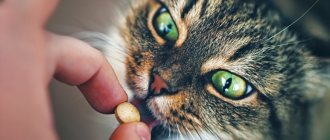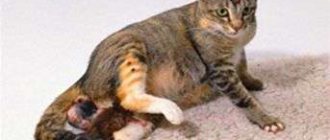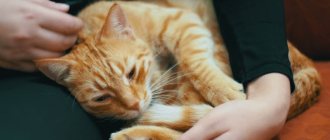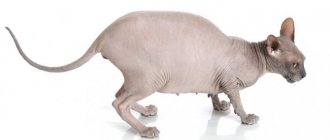Childbirth is one of the most important and dangerous moments in the life of any living creature. At this time, a new life is born, but in some cases, if no help is provided, the birth can end in the death of either the cat or her kittens. Therefore, every owner/housewife should know in detail about childbirth.
Read also: How many kittens does a cat give birth to for the first time?
How to set up a place for childbirth
Before you learn how cats give birth, you need to study the nuances of preparing a cozy place. It is best to find a box, a kind of “maternity corner”, on the bottom of which lay newspapers and soft blankets.
A suitable location meets the following criteria:
- availability. The box or tray should not be placed high. It is best to place it in a secluded place, from where it will be convenient for the owner to observe and help if necessary;
- sizes. After giving birth, pets will live in the installed box for another 1.5-3 months, so the space should be spacious;
- the birthing place should be located in silence, away from drafts. Experienced owners even allocate a separate room, for example, a bath, toilet, storage room.
Knowledge and willingness to support the animal will help keep babies and mother healthy
What is included in the owner's kit for first-time and experienced cats:
- sterile gloves;
- sharp scissors;
- wet antibacterial wipes;
- bowl of water;
- clean cotton cloth;
- cotton buds;
- syringe;
- a bowl for collecting used utensils;
- antiseptic for cats;
- terry towel;
- cotton wool;
- formula from a pet store;
- rubber bulb;
- potassium gluconate;
- oxytocin and levomekol.
Signs of the onset of labor
The first time labor usually makes itself felt 24 hours before the onset of contractions. In experienced cats, clear signs appear 1-4 hours before labor. The beginning of the process depends not only on the age of the pet, but also on individual characteristics.
When kittens open their eyes: how many days after birth
The first signs of impending birth:
- decreased appetite. The cat begins to drink a lot, in addition to water, prefers milk and broth;
- the cat is lethargic and almost constantly lies in the box;
- Before the onset of contractions, you may notice active movement in the abdomen. Thus, the kittens try to take the most comfortable position for birth. This sign is often noticeable already 1-2 days before birth in representatives of large breeds (for example, Maine Coon);
- active licking of the genitals. In this way, the cat cleanses the organ to prevent the development of infections in kittens;
- About an hour before giving birth, the cat's birth plug comes off. Usually it is not difficult to notice, since it resembles a white-pink clump;
- before starting the process, the temperature is reduced to 37 °C. Experts recommend monitoring this indicator to prevent bleeding during and after childbirth;
- by the time of childbirth, the nipples swell as much as possible, and if pressure is applied to them, colostrum will appear;
- 5-6 hours before birth, false contractions may appear. In this case, the cat behaves restlessly, often hunching over, and meowing. The process helps the kittens to finally prepare for birth, and the vascular system of the uterus to contract in a timely manner;
- the main and main sign of the onset of labor is the breaking of water. They can leave either a few hours before or at the birth of the first kitten.
After the first signs begin to appear, it is necessary to monitor the behavior and condition of the cat. In this case, the owner will not miss the process itself and, if necessary, will come to the rescue.
Important! It is necessary to ensure that the cat does not go to give birth in an unsuitable place where access to her will be limited.
Mating and early pregnancy
How to determine if a cat is pregnant? A healthy cat is usually ready to breed within 8-10 months after birth. In some individuals, estrus may begin even earlier - already at six months of age.
However, this does not mean at all that it is time to start looking for a cat. It is optimal to carry out the first mating at the age of 1-1.5 years. By this point, the cat’s body will be sufficiently strong and will be finally ready to bear offspring. So, the mating happened.
But how can you determine if a cat is pregnant at home? It is quite difficult to answer this question. From the moment of mating until the end of the heat, the cat continues to ask the cat, lie around and show all the signs of “desire”. So it’s not possible to immediately understand how successful the mating was.
The first obvious symptoms of pregnancy in cats become visible only at 3 weeks. In general, the length of pregnancy in British cats can vary between 8-9 weeks.
Determining the gestational age of cats is quite problematic. But there are still some guidelines. Between 15 and 21 days after conception, the cat's nipples become swollen and pink. This is what indicates that kittens will soon appear in the house.
The behavior also changes slightly: the pet becomes calmer. During this period of pregnancy, cats experience an increased appetite.
Premature birth
Normally, a cat gives birth without complications, and she is able to prepare the site herself and give birth to kittens. However, in some cases, hormonal imbalances occur, which lead to miscarriage and premature birth.
How long do cats live at home?
Symptoms of miscarriage:
- increased body temperature;
- restless behavior;
- frequent contractions;
- blood and mucus are released from the genitals;
- yellow or clear water appears.
Veterinarians identify several main causes of premature birth:
- death of kittens in the womb. This symptom is difficult to diagnose in advance. However, cats instinctively sense non-viable offspring, which must be removed from themselves. The veterinarian can try to stop the contractions, then the cat will give birth later, but the kittens will still die;
- an infectious disease that a cat picked up while mating or walking outside. In this case, the birth is not stopped, as there is a risk of harming the cat. She miscarries prematurely, resulting in dead kittens. If the body managed to survive, then the cat will be able to carry the rest of the babies until a certain period;
- Placental abruption at less than 56 days of gestation ensures death for kittens. In this case, you should not waste time, as this often causes internal bleeding.
Important! If premature birth begins, it is first of all important to help the cat. It is necessary to take her to the veterinarian for examination.
When it is not possible to go to a doctor, it is necessary to conduct a consultation by telephone. All this time, the owner must be with the cat, calm it down and stroke it. The animal can independently delay or stop labor if necessary. To relieve early contractions, it is recommended to use no-shpa, but you should not do this without a doctor’s permission.
Kittens can survive for more than 51 days; if miscarriage occurs earlier, then there is no point in saving them.
If it was not possible to determine the cause of premature birth, then there is no need to interfere with the process. If babies are born alive, they have every chance of a full life. If the offspring turns out to be dead, they are immediately removed from the mother.
When a cat has successfully given birth early, it is still necessary to take her to the veterinarian. It is best if the doctor comes to your home, since going to hospitals during the postpartum period will become stressful for the cat.
Childbirth: how long should it last in theory and in practice
We are interested in the first stages of childbirth, at the moment of which the offspring are born. Immediately after the stage accompanied by a decrease in general body temperature, the main stage of the birth process begins. During this period, the cat begins to become very worried and nervous (this is especially true for primiparous animals).
You may notice shortness of breath, a sudden increase in your pet's activity, or a refusal to eat. In rare cases, vomiting is observed (but during normal labor it is quite rare). The cat also exhibits "nesting" behavior. Once again, show your pet the box or basket in which she should give birth. Talk to the animal, stroke it, calming it down. Sometimes placing some old clothes in the basket, saturated with the owner's scent, helps. This “aromatherapy” calms many cats, as a result of which the pet no longer tries to escape and give birth on your bed.
So, the first stage normally lasts from 6 to 12 hours . During this period, the cervix should fully dilate and relax. In cases where, after 24 hours, no signs of the onset of labor appear, we strongly advise you to seek help from a veterinarian.
Features of childbirth
How many days does a cat walk: examples for the first time and how long in time
The first stage of labor begins 6-12 hours before the kittens are born. In primiparous cats, this process can take from 20 hours. The cat begins to behave restlessly, meows often, and muscle contraction is noticeable on the abdomen.
By the beginning of the second phase, contractions intensify, and the process moves to the next stage
The duration of this period is from 4 to 14 hours. The report is made from the moment the fetus enters the pelvic canal. At this time, amniotic fluid is released and the muscles rapidly contract. The cat helps the baby to be born through her efforts.
The fetus emerges from the canal in a special membrane that protected it in the uterus. At this moment, the cat's instinct kicks in and she begins to lick the kitten, cleansing the blood and stimulating the respiratory system.
Childbirth is considered complete when there are no contractions for about 2 hours. The cat looks calm, the abdomen subsides and becomes soft. Babies are actively sucking milk at this time.
Note! A cat is healthy if, after giving birth, it eats and drinks well, moves around, takes care of the babies, and breathes evenly.
The main signs of the end of labor
You can understand that a cat has given birth to her last kitten if:
The pet’s breathing has evened out; The cat begins to be active, change its position and even move away from its kittens for a while; Begins to be interested in his own children, lick them and feed them; Heart function is normalized; Some time after the cat has given birth to all her kittens, she begins to feel the desire to eat and drink; One hour after the birth of the next baby, the cat’s belly becomes soft, without any compaction.
It is worth remembering that the volume of the abdomen is not a guaranteed indicator that labor is over or, on the contrary, is still ongoing. Even if childbirth is over, the stomach does not always decrease in size quickly enough. At the same time, the uterus, which still retains its tone, may well be confused with an unborn kitten by a pet owner who does not have the proper experience.
If you nevertheless decide to palpate the abdomen, then this should be done very carefully, without making any effort. In this case, you need to run both hands along the ribs. This should be done half an hour after the last kitten was born.
It is possible to check using special preparations. Usually, oxytocin is used for this, which must be injected into the cat. The dosage is no more than 0.3 ml. This drug has a stimulating effect on the uterus, which helps the kittens remaining in the womb to emerge. If all the babies have already been born, then it will still be beneficial, helping to free the uterus from the mucus accumulated there.
However, you should not use this medicine for every birth. In fact, it is intended for extreme cases, for example, when the abdomen cannot be felt and the cat is not showing signs of the end of labor. It is strongly recommended not to use this medication on your own . It is best, if you have any doubts about the presence of kittens in the womb, to call a veterinarian who will conduct a diagnosis and decide on the advisability of certain actions. Also, before using oxytocin, he will check if the cat is allergic to this drug.
Of course, in most cases, a pet can give birth perfectly well on its own, without outside help. However, this does not mean that you should not leave everything to chance. Attention to your pets during the birth process will help preserve their health and even life.
How does the first birth go?
A cat is considered sexually mature when she is 7 months old and begins to go into heat. However, you should not rush into mating. For example, British cats are able to bear healthy kittens only after 1 year of life.
Owners are usually more afraid of the first birth, since cats have strong instincts that help them overcome the ordeal. If the animal is healthy, then there is no reason to worry. Usually everything goes without complications, so it is enough for the owner to be nearby.
At first, contractions gain momentum in intensity and become more and more frequent. Then, through efforts, the baby is born.
Important! The cat must give birth in a lying position, so you need to watch and not let her sit up.
Since childbirth is taking place for the first time, the cat may be confused, so the owner will have the role of cutting the umbilical cord using scissors.
Owners of Scottish and other breeds often have to rid kittens of the amniotic sac if the cat does not do this.
The interval between the appearance of kittens can be up to 1.5 hours, so there is no need to worry about this
How to understand that a cat has given birth to all kittens
It is very important to understand whether the birth process is over or not, since the fetus remaining inside can seriously harm the cat. In such cases, it begins to decompose inside, exposing the body to intoxication. There are often cases when the unborn dried out in the womb, disrupting the reproductive function of the cat.
Lambing was completed successfully if:
- the temperature is normal, the cat’s breathing is even;
- she is with kittens;
- the animal actively eats and drinks fluids;
- sleeps peacefully;
- the stomach is soft.
Which cats need help during childbirth?
Most cats do not need assistance when giving birth. It is enough for the owner to observe from the outside so that the process proceeds normally.
It is possible that problems may appear in healthy cats, but primiparous and weakened cats are at risk. Particular attention should be paid to animals with problems of the respiratory and cardiovascular systems. These cats often undergo a cesarean section and are then sterilized.
Artificially bred breeds have the hardest time. In this case, the maternal instinct may be absent, so the role of the mother will shift to the owner.
Important! Owners of fold-eared breeds often note problems in primiparas.
Young cats may be frightened by unusual sensations, so the owner will need to take part in labor.
How to help during childbirth
When the owners have managed to figure out how kittens are born, they need to learn how to provide assistance during childbirth.
It happens that labor activity suddenly stops or weakens. In this case, there is no need to worry, as in cats labor often stops and then resumes after a few hours.
You can stimulate the process by stroking the nipples and abdomen
Important! Inducing labor with oxytocin should only be done after consulting a veterinarian. Otherwise, the drug will harm the cat and kittens.
What not to do
At the time of labor you should not:
- independently prescribe and administer medications;
- stop contractions;
- pulling kittens out of the birth canal by the paws and head;
- Allow the cat to sit.
Problems during childbirth that you can solve on your own
When a cat gives birth and cannot cope with the kittens on her own, the owner can perform some auxiliary actions:
- if the integrity of the amniotic sac is broken, you need to wrap the kitten with a cloth and pull it slightly towards you at the moment of contraction;
- if the fetus comes out with a damaged bladder, not the head, but the butt, it is necessary to pull immediately so that the baby does not suffocate;
- when the kitten gets stuck in the tracks, you need to lubricate them with Vaseline;
- if the cat does not open the amniotic sac, the owner must cut it himself and remove the baby;
- the umbilical cord can be tied with a sterile thread and cut with scissors at a distance of 2 cm, then the area can be treated with an antiseptic;
- If the kitten is born unconscious, it is necessary to massage the heart, clear the airways and apply it to the mother's nipples.
If something does not go according to plan during the process, it is best to consult a doctor. A qualified veterinarian knows how to properly deliver a baby and also provide assistance if necessary.
How does the process of childbirth in a cat end or the final stage?
The third period in childbirth is considered to be the release of each kitten from its birth place or placenta. An animal can eat each of them, which is considered normal. It is better to monitor the exit of the placenta, because... remaining in the cat, it can cause inflammatory processes and a visit to the veterinarian will be required.
Also, eating the entire afterbirth (placent) can lead to intestinal upset and cause diarrhea. It is also worth noting that some felines do not eat placenta, everything is very individual.
A happy family
Usually the cat is its own obstetrician and gnaws the umbilical cord on its own. If the umbilical cord is bitten very close to the navel, this can cause bleeding.
Owner's actions. You need to tie the umbilical cord with a thread, squeezing it, then it is cauterized with some kind of antiseptic, for example, you can use iodine. Do not pull too hard on the umbilical cord, otherwise the baby may develop a hernia.
After all the kittens are born, the new mother pushes them with her paws towards her stomach, closer to the nipples. It is very important for kittens and cats to receive this early feeding. First, children will receive colostrum, which contains the mother's antibodies. Secondly, sucking promotes contraction of the uterus, and therefore its rapid restoration and healing.
The first 24 hours after birth
In the first time after childbirth, it is necessary to provide cozy and calm conditions for mother and babies. You need to put a clean sheet in the box and add a warm heating pad if necessary.
At first, it is necessary to independently apply the babies to the nipples so that they actively feed
The best food to give your cat is:
- milk;
- cottage cheese;
- boiled vegetables;
- chicken meat;
- sour cream.
Important! In the first month after lambing, you should not feed the animal dry food, as it contains a large amount of salt. It is advisable to purchase vitamins for the mother cat that contain calcium.
Do I need to be examined by a doctor?
Despite the fact that childbirth often occurs without complications, consultation with a veterinarian is still necessary. During the examination, the doctor will confirm that the mother and kittens are healthy, because some pathologies are not immediately detected.
Depending on how the birth takes place, the health of the mother cat and the babies depends. Studying the processes and names of each stage of lambing in a pet will help the owner not to get confused at such an important moment and provide first aid. As the cherished date approaches, a person should carefully monitor the cat’s behavior so as not to miss the main symptoms.
Cat nutrition during pregnancy using the example of British cats
In order for a British cat to have a pregnancy without pathologies, she needs to be fed correctly. So it’s time to say a few words about the diet of a pregnant British woman and her diet.
Immediately after mating, you need to increase the amount of feed by about 10%. This will not harm even if conception does not take place. However, to prevent your cat from becoming fat, you should not increase the amount of food in the bowl, but introduce one additional feeding per day.
As soon as the first symptoms of pregnancy appear in cats, nutrition should be increased by another one and a half times.
At about 7 weeks, the cat begins to eat significantly less, and closer to giving birth, it may even refuse food altogether. Pregnancy of cats is “to blame” for this and diseases have nothing to do with it. This behavior is due to the fact that the animal’s abdominal cavity is almost completely filled with unborn offspring. During this period, the amount of food can be slightly reduced, returning the pet to its normal diet.
Now about the diet. For the entire period of pregnancy in British cats, fish and cheap food should be completely excluded.
But without fail, the cat should be given beef scalded with boiling water, milk and dairy products. Depending on the preferences of the expectant mother, this could be cottage cheese, kefir, low-fat yogurt, etc.
It is recommended to offer your little predator raw vegetables such as carrots and cabbage, as well as buckwheat and rice porridge. Most likely, a pregnant British cat will choose one of these products to give her unborn kittens the substances they need for development.










